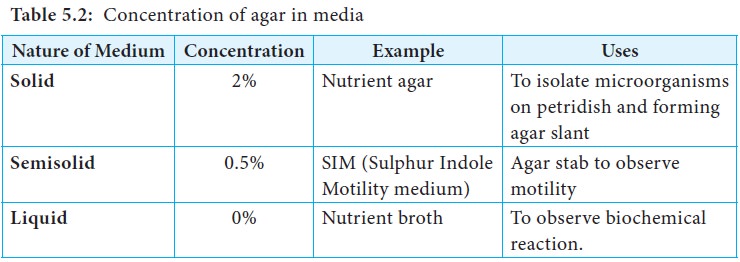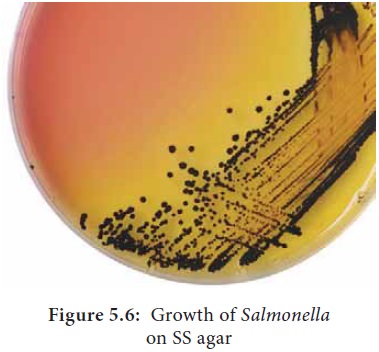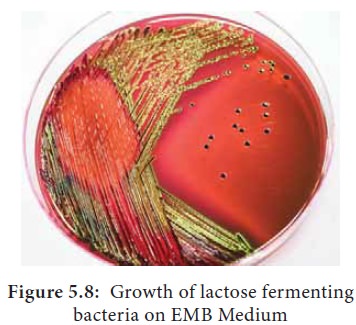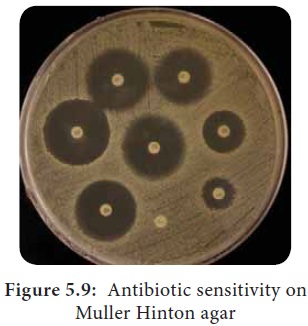Chapter: 11th Microbiology : Chapter 5 : Cultivation of Microorganisms
Bacteriological Media and its Types
Bacteriological Media and its
Types
Generally microorganisms
occur as mixed culture in nature. Human beings, animal bodies and other natural
resources harbour microbes in mixed population. By using appropriate media,
microorganisms can be grown separately in pure form and can be studied. For
successful cultivation of a given microorganism, it is necessary to understand
the nutritional requirements of that microorganism and then supply the
essential nutrients in proper form and proportions in culture medium. Flowchart
5.1 describes the types of media. A common bacteriological medium has Carbon
and Nitrogen sources along with buffering agents. Most of the media are
prepared using dehydrated components. The basic components are peptone, beef
extract, meat extract, yeast extract and agar (Table 5.1).


Uses of agar:
·
It is one of the principle ingredients in the preparation of
solid or semisolid media.
·
It is used as a solidifying agent in culture medium.
· It is extracted from certain seaweeds belonging to genera of red algae like Gelidium and Gracilaria (Figure 5.1).

·
It is a sulphated polymer mainly consisting of D-galactose.
·
Agar is a highly preferred solidifying agent because it does not
affect the growth of microorganisms. Agar is also used in the food and
pharmaceutical industries.
·
The purified form of the agar is called Agarose. It is prepared
by removing the pectin from the Agar. It is used in Molecular Biology
laboratory for the separation of DNA molecules by gel electrophoresis.
Physical Nature of Agar Medium
The concentration of agar plays a major role in determining the consistency of the medium. A medium with agar concentration of 2% or greater is said to be a solid medium and that of 0.5% is said to be a semisolid medium (jelly like appearance). Tabel 5.2 lists the concentration of agar in media. However liquid media (broth) does not contain agar. Figure 5.2 shows types of media depending on physical nature.


Chemical Nature of Medium
Synthetic medium
Chemically defined synthetic Medium is used for various
experiments. This medium is prepared exclusively from pure substances with
known chemical composition and concentrations. This is widely used in research
to find the type of compound metabolized by the experimental organism.
Non-synthetic medium
The medium in which the exact chemical composition and the concentration of each ingredient is not certainly known is called non-synthetic medium. In this medium, crude materials such as meat extract, yeast extract, various sugars, molasses and corn steep broth are used. This supports the growth of a variety of microorganisms. It is otherwise called as complex medium.
Special Purpose Medium
i) Basal medium
This medium promotes the growth of many types of microorganisms
which do not require any special nutrient supplement. It is a routine
laboratory medium with Carbon and Nitrogen sources along with some minerals.
Example: Nutrient Agar or Nutrient Broth. It is also called general purpose
medium. It is used for subculturing the pathogens. It is a non-selective
medium, which is designed to support the growth of a wide spectrum of heterotrophic
organisms. (Figure 5.3)

ii) Enriched medium
In enriched medium, substances like blood, egg or serum are
added along with the basal medium. It is used to grow fastidious organisms that
are very particular in their nutritional needs. Fastidious organisms have
elaborate requirements of specific nutrients like vitamins and growth promoting
subtances and or not easily pleased or satisfied by ordinary nutrients
available in nature. Example: Blood agar is used to identify haemolytic
bacteria (Figure 5.4) and Chocolate agar used to identify Neisseria gonorrhoeae.

iii) Selective medium
Selective medium contains one or more agents (selective
components) that inhibit unwanted organisms but allow the desired organisms to
grow. Growth of unwanted microbes is suppressed by adding bile salts,
antibiotics and dyes. Example: Mannitol salt agar is selective for Staphylococci. This medium contains 7%
Sodium chloride that inhibits the growth of other bacterial population but
allows the growth of Staphylococci
(Figure 5.5). Moreover it has Phenol red dye to indicate acid production. Staphylococcus utilizes Mannitol and produces acid which changes the colour
of the Phenol red indicator to yellow. Salmonella-Shigella (SS) agar is
selective for Salmonella (Figure
5.6).


iv) Differential medium
Differential medium distinguishes between different groups of
bacteria and permit tentative identification of microorganisms based on their
biological charaterstictics as they cause a visible change in the medium. We
can differentiate haemolytic and non-haemolytic patterns of bacteria using
blood agar. Differential medium is otherwise called indicator medium as it
distinguishes one organism from another growing on the same plate by the
formation of pigments due to its biochemical and physiological nature. Example:
MacConkey agar medium has neutral red dye. Lactose fermentors form pink
coloured colonies and non fermentors form colourless translucent colonies on it
(Figure 5.7).

Eosin Methylene Blue (EMB) agar medium is also a differential
medium. It is used to differentiate lactose fermentors from non-lactose
fermentors. It has lactose sugar and two dyes namely Eosin –Y and Methylene
blue. These dyes act as inhibitory agent towards Gram positive bacteria.
Example: Lactose fermentors such as faecal Escherichia
coli show metallic sheen and non
lactose fermentors such as Enterococcus
do not show metallic sheen. (Figure 5.8).


v) Enrichment medium
Enrichment medium is a liquid medium. It is used to grow a
particular microorganism that is present in much smaller number along with
others present in sufficiently large numbers. An enrichment medium provides
nutrients and environmental conditions that favour the growth of a desired
microorganisms. It is used to culture microorganisms present in soil or faecal
samples that are very small in number. Example: Selenite F Broth is used to
isolate Salmonella typhi present in
low density in faecal sample. It is
cultured in an enrichment medium containing Selenium. Selenium supports the
growth of the desired organism and increase it to detectable levels compared to
intestinal flora. Sodium selenite inhibits many species of Gram positive and
Gram negative bacteria including Enterococci
and coliforms.
vi) Antibiotic sensitivity medium
Antibiotic sensitivity medium is a microbiological growth medium
that is commonly used for antibiotic sensitivity testing. Example: Muller-
Hinton agar medium. It is a non-selective and non-differential medium. It
allows the growth of most type of microorganisms. It contains starch which
absorbs toxins released from bacteria. Hence toxins do not interfere with
antibiotics. Agar concentration of 1.7% is used in this media which allows
better diffusion of antibiotics (Figure 5.9).

vii) Anaerobic medium
Anaerobic medium is a medium used for the cultivation of
anaerobes, Example: i) Robertson cooked meat medium: This is used for the
isolation of Clostridium ii) Thioglycolate
broth: In this medium Sodium thioglycollate is used as a reducing agent which
maintain a low Oxygen tension by removing the molecular Oxygen from the
environment.
viii) Transport medium
Transport medium is used for the temporary storage of specimens that are being transported to the laboratory for cultivation. It maintains the viability of all organisms in the specimen without altering their concentration. It mainly contains buffers and salts. Example: Stuart’s transport medium that lacks Carbon, Nitrogen and organic growth factors. Other examples of transport media are Cary Blair and Amies.
Exceptions in cultivation of
microbes in artifical medium
Some bacteria like Mycobacterium
leprae and Treponema pallidum
cannot be cultivated in artificial medium.
ix) Media used for isolation of fungi
Apart from the bacteriological media, fungal media are used to
study fungal morphology pigmentation and sporulation. Sabouraud’s Dextrose Agar
(SDA) is used as a common medium to isolate fungus. There are several other
important fungal media used for fungal cultivation. Examples Niger Seed Agar
and Potato Dextrose Agar

Related Topics